From the Romantic Loire Valley to rustic Provence and prestigious Bordeaux, there are too many beautiful castles in France to comfortably visit in a single trip. It might even take three or four visits to cover the country’s finest chateaux, fortified castle towns, and handsome estates, the latter owned by some of France’s most powerful old families. Still, with our expertise and guidance, you’ll embark on a bespoke adventure that brings together architecture, history, fine dining and opulent overnight stays. Keep reading for an at-a-glance look at 40 of the most breathtaking castles across the country. If we succeed in inspiring you, get in touch with us so we can start crafting the perfect, chateau-centric luxury getaway for you.
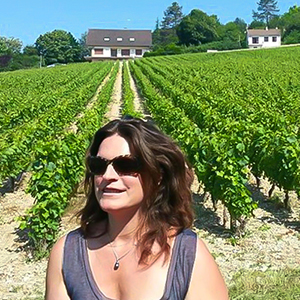
Founder
There are too many sublime castles in France to see in one trip, but with our expertise you can explore or even stay in a few marvellous examples.
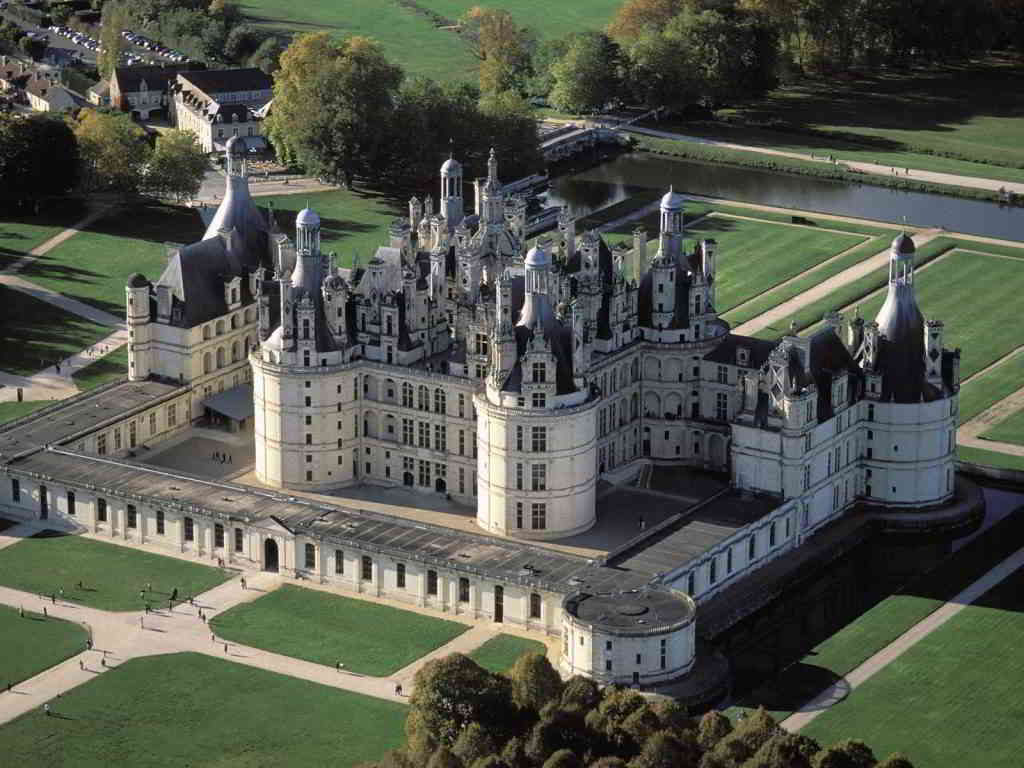
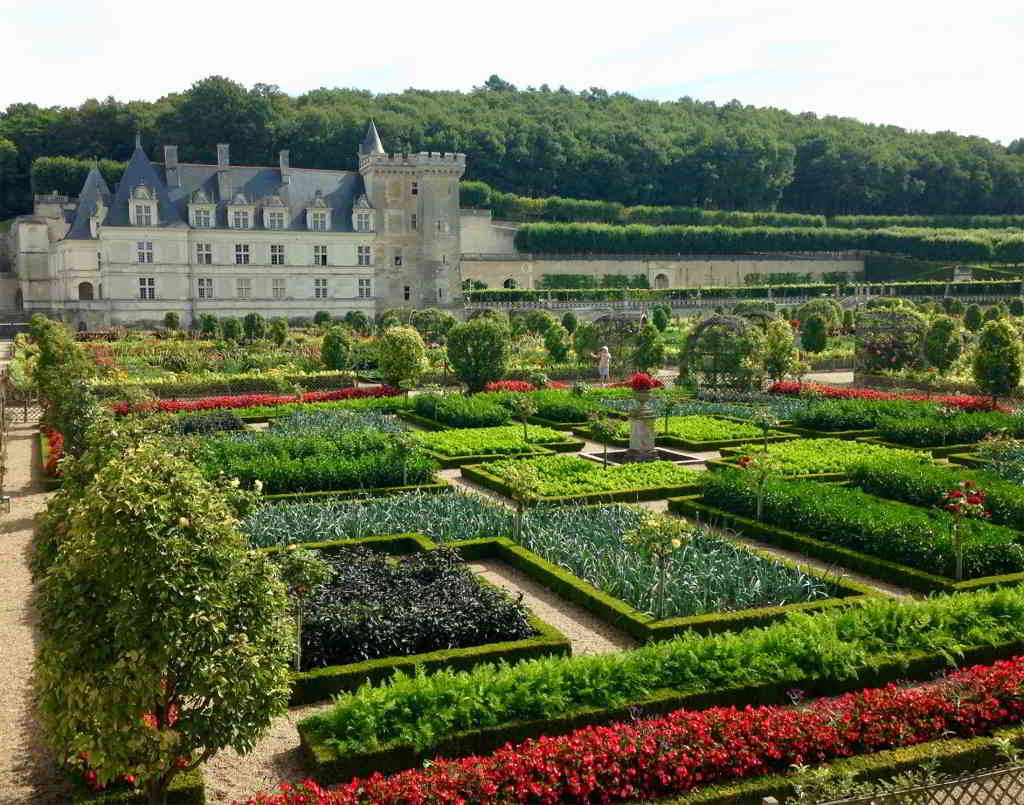
When most people hear the term “French chateau”, they either think of Versailles (see more about that by scrolling down to the Paris section) or of the mythical Loire Valley. Studded with sprawling, elegant chateaux that point to the height of French Renaissance architecture and its unusual harmony, the Loire often feels like a place more befitting of a fairy-tale than “real” life.Let us start with the Chateau de Chambord, which many consider to be the region’s finest castle. Bringing together medieval and Renaissance-style architectural elements, Chambord is the Loire’s largest chateau. Never truly completed, it features dramatic details that you won’t soon forget, including purely ornamental fortified walls and moat, seemingly endless spiral staircases and lush, teeming gardens. You can even stay on the property if you so choose, at one of Chambord’s three and four-star “gites” (country lodges), which afford splendid views over the castle and gardens.
Seeking the fairy tale feeling? How about visiting the castle that inspired French writer Charles Perrault to write Sleeping Beauty? The Chateau d’Ussé is a literary castle par excellence: it was inhabited by Perrault himself, then later by fellow French author Chateaubriand. Today, the privately owned castle accepts visits– and it’s certainly worth one. A dramatic drawbridge, dungeon, vaults and sublime tapestries are among the many lures at this otherworldly chateau.
Fan of Leonardo da Vinci’s mesmerizing art and inventions? The Chateau du Clos Lucé is a remarkable castle that served as a residence for the Italian artist in the years just prior to his death in 1519. Located in the charming Loire Valley town of Amboise, the chateau bears an unusual Renaissance-era design featuring distinctive, rose-hued brick and freemasoned structure. As a result, the fifteenth-century castle has the bearing of a stately manor. Da Vinci’s legacy at the castle is quite marked: you can see around 40 models of his ingenious machines and other inventions in one of the rooms; in another, a striking replica of the artist’s famous painting the Mona Lisa awaits, painted by Ambroise Dubois. Famous owners of this unforgettable chateau include France’s King Charles VIII, who used it as a “pleasure castle” for his wife, Anne de Bretagne.
Another breathtaking Loire Valley castle associated with Da Vinci is the Chateau d’Amboise, a residence for French Kings between the 15th and 19th centuries whose dramatic, medieval-style fortress adds a genuine sense of grandeur. Monarchs and royals from Henri I, King of Navarre to Anne Boleyn and Charles XI took up residence. This was also Da Vinci’s last residence before his death and his tomb reposes in the Chapel– making the chateau an essential stop for anyone interested in the artist and his life. The dramatic architecture, featuring dramatic towers, balconies, rooftops offering panoramic views over the Loire Valley and River, and lush formal gardens, is a feast for the senses.
Spanning the River Cher, meanwhile, is the equally legendary Chateau de Chenonceau, an early 16th-century feat of Renaissance architecture that was built on the site of a former mill. This easily explains why the castle was built on both sides of the river, to unusual and gorgeous effect.
Famous for its impossibly beautiful gardens, the Chateau de Villandry speaks loudly for the talents of French landscaping artists of the 16th century. After falling into semi-obscurity, the gardens were restored to their original glory in the 20th century by a private owner. Today, in addition to the formal shrubbery and flowers, organic vegetables grow here– ushering it into the 21st century. Meanwhile, the Chateau itself is stately but a bit more subdued than its flashier, larger neighbours. A private tour here can really help unlock the quieter side of the Loire and its distinctive beauty.
A medieval Loire-Valley treasure is the Chateau de Chinon, a fortified castle and town with origins in the 10th century. The Counts of Anjou once ruled from here, and the chateau is also famous for having imprisoned several members of the Knights Templar after King Phillip IV accused the order of heresy in the early 14th century. Today, the castle and its heavy fortified walls still have something of the epic about them.
Read more about the most beautiful castles in France’s Loire Valley here
Tasting & Staying in the Loire
Whether you’re a fan of whites, sparkling wines or reds, there are plenty of opportunities for luxury wine-tasting tours in the Loire. We’ll put together the perfect itinerary for you, balancing your days between visiting the region’s mythical castles and stopping to taste its finest vintages. Of course, a stay in a grand old castle is also a possibility. Just tell us what you’re envisaging, and we’ll do our best to bring the dream to vibrant life.
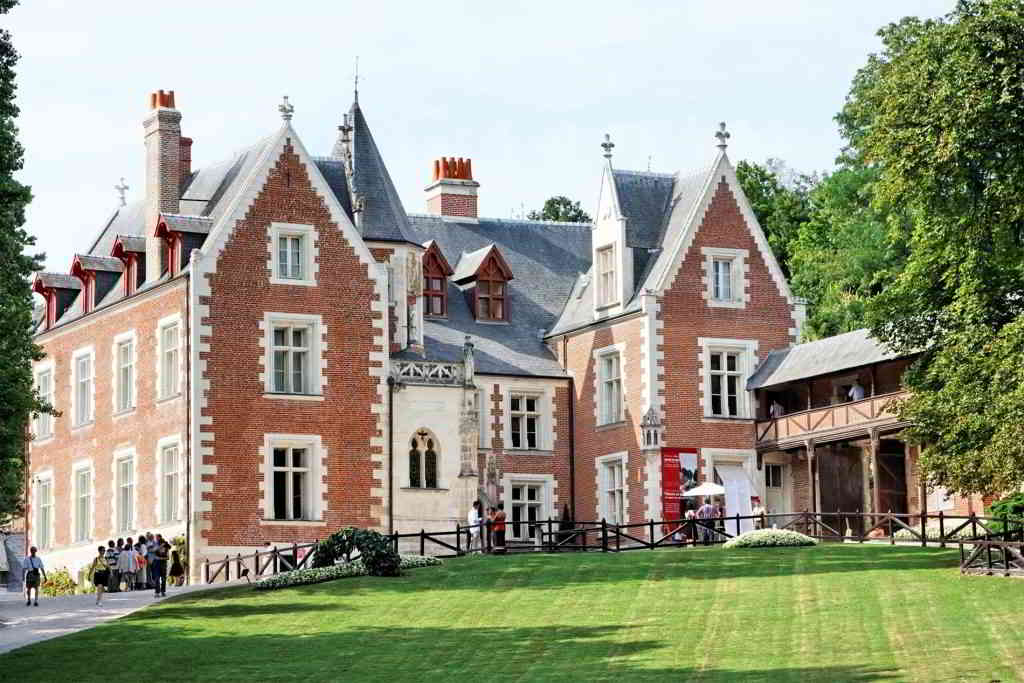
Provence, famous for its rolling hills of lavender, glamorous beaches and coastlines, centuries-old Abbeys and rustic bastides (country estates once owned by wealthy farmers) is also home to some awe-inspiring chateaux and fortified castles.
Start with the Palais des Papes in Avignon, the seat of the Catholic papacy during the 14th century. Construction began in the late 13th century and was completed in around 1309. Several popes occupied the massive fortified palace, which boasts the surface area of four Gothic cathedrals and remains awe-inspiring. Visit the private rooms of popes, treasuries and wall frescoes painted by Italian artist Matteo Giovannetti. The monumental complex is in fact divided into two separate and conjoined palaces: the older palace of Benedicte XII, built into the top of the massive Dom rock, and the newer palace of Clement VI. The powerful fortifications, ornate and world-famous Benezet bridge (also known as the “Pont d’Avignon”) and surrounding town should be on any luxury travel bucket list– especially for those with interests in history, architecture and culture.
Far lesser-known than the Palais des Papes, the Chateau de Tarascon is one of Europe’s most beautiful and well-preserved fortified castles. Towering over the Rhone river, Tarascon is a 13th-century fortress built by the dukes of Anjou, then later occupied by Kings including Louis III and René I. Wander through more than 30 elegant, epic rooms, from princes’ bedrooms to the “Hall of Honour”. From the 15th century to the early 20th, part of the castle served as a prison. The views over the river and the surrounding valley are also stunning.
Moving to the Cote d’Azur, it’s important to remember that the region has more to offer than star-studded yacht parties and luxury boutiques. History abounds in structures such as the Chateau d’Antibes, a 17th century fortified castle that was built by the Grimaldi royal family. Today, it houses the stunning Picasso Museum and offers sweeping, unforgettable views of the Mediterranean in the near distance.
Associated with the same royal family is the legendary Château Grimaldi, a historic castle and museum located in Cagnes-sur-Mer on the same hilltop, sea-facing site as a centuries-old fortress once occupied by Greeks and later Romans. The castle that now stands there was constructed in 1309 by Rainier Grimaldi, Lord of Cagnes and a French admiral who was also distantly related to the current-day royal House of Monaco. After the French Revolution of 1789, the Chateau was transformed into army barracks, before being taken over by the city of Cagnes and turned into a museum open to the general public. Towering over the town of Cagnes, the castle still conveys French royal power and elegance, with a dramatic medieval tower and keep and distinctive design motifs. Its triangular courtyard forms the center of the design. Especially noteworthy are the Great Hall and the chapel, each decorated with original frescoes and ceiling paintings. Contemporary and modern art exhibits are also regularly held here.
The Fort Royal on the Island of Sainte-Marguerite, meanwhile, is an impressive historic castle situated offshore from Cannes, whose hundreds of years of royal history make for a fascinating expedition. Constructed around 1617 on the orders of the Duke de Guise, the defensive fortress was developed further by the Spanish, who occupied the island from 1635. But it wasn’t until the end of the 17th century that the fortifications were completed and made to resemble what we still see today, under the direction of French King Louis XIV. Looming 26 meters above sea level, the fortress offers breathtaking views over the Mediterranean and the land beyond, including Cape Croisette. Visitors can tour the impressive remparts, chapel and compound within, which includes former cells from the era during which the fortress was used as a state prison.
With its lush gardens, sweeping sea views and centuries of history stretching to the medieval period, the Château de la Napoule is a gem situated in the town of Mandelieu-la-Napoule. Constructed during the 14th century, it bears all the architectural details of a typical castle from the Middle Ages– but in reality it has been rebuilt and restored several times. In 1918, the castle was in ruins, but it was purchased by two Americans, Henry and Marie Clews, who restored it to its former glory. Today, it houses the La Napoule Art Foundation and serves as a cultural center. The eye-catching formal gardens have earned the castle status as a notable garden of France by the French government.
In Marseille, meanwhile– a city too-often neglected by luxury travellers— the Chateau d’If is the stuff of true literary legends. Jutting out from a tiny island offshore from the city, surrounded by blue water, the Chateau and former prison was the setting for Alexandre Dumas’ iconic novel, The Counts of Monte Cristo. Walking around the remparts affords fantastic views over the Mediterannean and the coastal areas stretching far along it; as well as an understanding of why King Francis I elected to build the fortress as a protection against aggressive invasions.
Heading over to regal Monaco, the Prince’s Palace is an opulent fortified chateau that is one of the rare castles in France to still be occupied by a royal family. Situated on a rocky promontory overlooking the harbor of Monaco, this chateau worthy of epic tales is a sight to behold, thanks in large part to restoration efforts led by Prince Rainier III. Especially impressive is the royal courtyard, paved with three million, elaborately patterned white and colored pebbles. Inside, opulent columns and an impressive double-revolution staircase inspired by a similar one at the Chateau de Fontainebleau outside Paris are outstanding features. The regally appointed State Apartments, where the Prince receives guests to this day, are equally impressive. The chateau also houses the Napoleon Museum and Archives.
Castle Stays & More in Provence
Of course, these are only a few of the stunning castles ideal for a private tour of Provence. We’ll unlock so many more for you when you embark on a custom getaway with us, allowing you to relive the mythical power of some truly extraordinary monuments. And if you’re interested in a high-luxury stay in a centuries-old Provencal castle or Bastide, we’ll bring that vision to life.
Wine lovers flock to Bordeaux from all over the world to taste the region’s fine– and often very expensive– wines. But the region equally abounds with harmonious, fantastic architecture in the form of castles and manors. Some are centuries-old, some more recent. What most share is some involvement in the production of fine wines. Any high-end getaway to Bordeaux should including both wine tastings in the region’s finest cellars and domaines, and private explorations of some of its finest chateaux and manors. It’s important to note, though, that many of these are rather exclusive and not open to the general public; they can be visited on appointment only.
There are simply too many prestigious and magnificent winery-chateaux in the Bordeaux region to comfortably name, from the Médoc to the St-Emilion area. Alongside the iconic Chateau Margaux which is a global household name among luxury lovers, here are just a few castles noteworthy for their long history and architectural beauty. We’ll help unlock some of the area’s most sumptuous and renowned chateau-wineries for you, offering an exclusive look at the history and the winemaking.
The Chateau d’Yquem is a 400-year old castle just south of Bordeaux and located in Sauternes, a town celebrated around the world for the fortified, marvelously complex sweet white wine of the same name. The late 15th-century estate, plunged in vineyards, has been owned by various local counts and aristocrats over the course of its long history. Discerning luxury travelers flock to the Chateau for tastings of superb vintages, including the onsite winery’s Premier Cru Classe Supérieur (superior-class vintage), noted for its rich, complex flavors and delicate notes.
The painstaking process with which the chateau produces its wines is also noteworthy: each vine reportedly yields only a single glass of wine, making it all the more coveted, of course. Aged in oak barrels, the pleasantly golden fortified wine ages especially well. Some of the Chateau d’Yquem’s most-sought-after bottles are more than 50 years old.
A stunning medieval castle and winemaking estate dating to around 1540, the Chateau La Mission Haut-Brion is one of the most prestigious of the Bordeaux region’s centuries-old chateaux, but it also doubles as a Catholic mission– as its name suggests. The winery founded by the Bordeaux wine merchant Arnaud de Lestonnac, who purchased a parcel known under the name Arregedhuys. De Lestonnac’s family eventually entrusted the estate to an order of priests who continued to cultivate vineyards there for nearly 130 years, until the French Revolution in 1789.
After being seized by the state, it was once again sold to private families. Today, the Haut-Brion is managed by the Domaine Clarence Dillon. In the year 2,000, the Chateau was entirely refurbished by the Duchess of Mouchy, and is 2007, new cellars and a bottling center as well as a new tasting room with original woodworking by Albrecht Durer were installed. The crown jewel in the redesign is the so-called “Grand Chai”, inaugurated in 2009 as a “grand cathedral dedicated to wine” and as a tribute to the Lazarist brothers who once tended the vines. It comprises breathtaking cloisters, garden and tasting room.
Médoc Chateau-Wineries
Heading over to the Médoc side of the river, the Chateau Lafite Rothschild is not only one of Bordeaux’s most-prestigious wineries thanks to its association with the Rothschild family since the 19th century. Its grounds have centuries of history, stretching to the medieval period. Lafite has been mentioned in historic records as a fief since the 14th century. By the time the Ségur family established organized vineyards on the premises during the 17th century, there were probably already some vines present. When Jacques de Ségur’s heir, Alexandre, wed the heiress of the neighboring Chateau Latour, it joined the reputations and fortunes of both fiefs. Today, it is customary to visit the chateau by private arrangements only. If interested, ask us about a bespoke tour in the region and we’ll help you arrange one.
Also in the Médoc is the Château Latour, situated at the southeastern edge of the Pauillac winemaking appellation and only hundreds of meters from the Gironde estuary. The Chateau produces three superb red wines, including a “Premier Grand Cru Classé”(first-class vintage), and is widely coveted by collectors and wine amateurs. Vines have been grown on the site since the 14th century, and even during the medieval period the wines were considered among some of the finest in France.
The site is genuinely historic, too: the estate here dates to around 1378, and during the Hundred Years’ War a garrison fort was constructed nearby the estuary to protect from invasion. The estate was owned by the English until 1453 and the Battle of Castilion, when a tower occupying the site was destroyed. Today, a circular tower built during the 1620s stands on the site of the estate.
Also in the Pauillac appellation is the Château Mouton-Rothschild, famed for its expensive and highly-coveted red of the same name and enjoying wide public recognition. Nevertheless, this is one of the most exclusive wineries in the Bordeaux region. The Château’s vines stretch across 222 acres on the edge of the Médoc peninsula, close to the waters of the Gironde and the Atlantic ocean. The Chateau also owns a larger vineyard dating to the Gallo-Roman era.
The Château was purchased by the Baron Nathaniel de Rothschild in 1853. While the current-day “castle” that graces the premises is the result of many renovations and modernizing efforts, it is still lovely to visit, with old master paintings gracing the Column Room, and the Ramp Room with a graceful, sloping ceiling, tapestries and statuary. Visitors can also enjoy the Museum of Wine in Art, whose collection of rare artworks on the theme of wine is held in the chateau’s former barrel hall.
Winery Chateaux in St-Emilion
The medieval walled town of St-Emilion is one of the Bordeaux region’s most-precious sites for fine wines. There are too many to comfortably count in a single article, but these chateaux carry the prestigious honor of having had their wines receive “Premier Grand Cru Classé” status– alongside the Château Angelus and Château Pavie. This makes them essential for luxury wine tasting in the region– and the chateaux are lovely to visit, too.
The Château Ausone has long been lauded by wine enthusiasts for its distinctive, complex vintages, produced thanks to an unusual terroir composed of sand, clay and limestone. The vineyard, measuring 17 hectares, produces relatively low yields, making the finished product even more sought-after by collectors and investors. Only around 2,000 cases of the Grand Vin are produced every year.
Situated on a steep cliffside where the sloping vines are exposed to ideal climatic conditions, the Chateau Ausone was established in the 18th century. The chateau is today managed by Alain Vauthier, who runs the winemaking operations with his daughter Pauline. The premises are rumored to have once harbored an ancient 4th-century villa that belonged to the famed Roman poet Ausonius, and the remains of an ancient villa can indeed be seen in the lower part of the estate.
Wine Tours & Luxury Chateau Stays
When you embark on a private wine tour with us, we’ll work with you to create an entirely personalised excursion around this mythic region that combines tastings in the area’s finest cellars and vineyards with guided explorations of local chateaux and domaines. And if you’re interested in staying in one or even staging a special private event, that’s entirely possible too. “Limitation” is not a word in our general vocabulary, when it comes to showing our VIP clients the very best France has to offer.
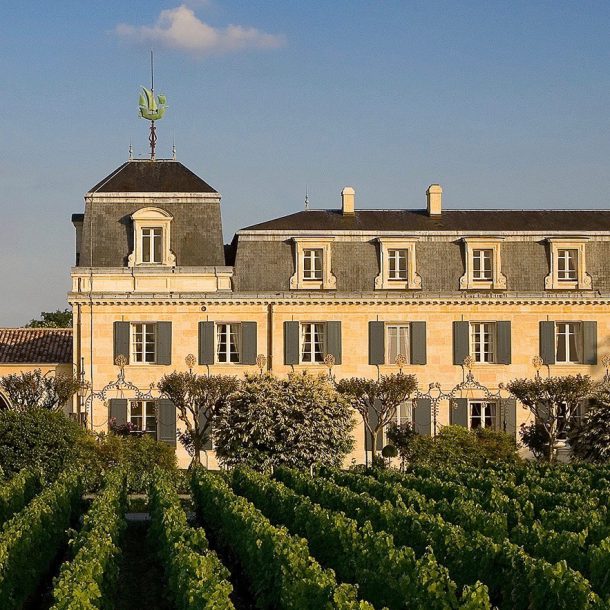
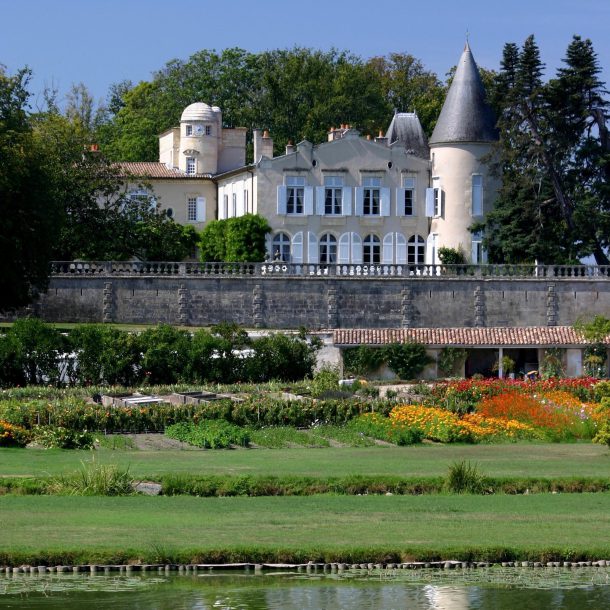
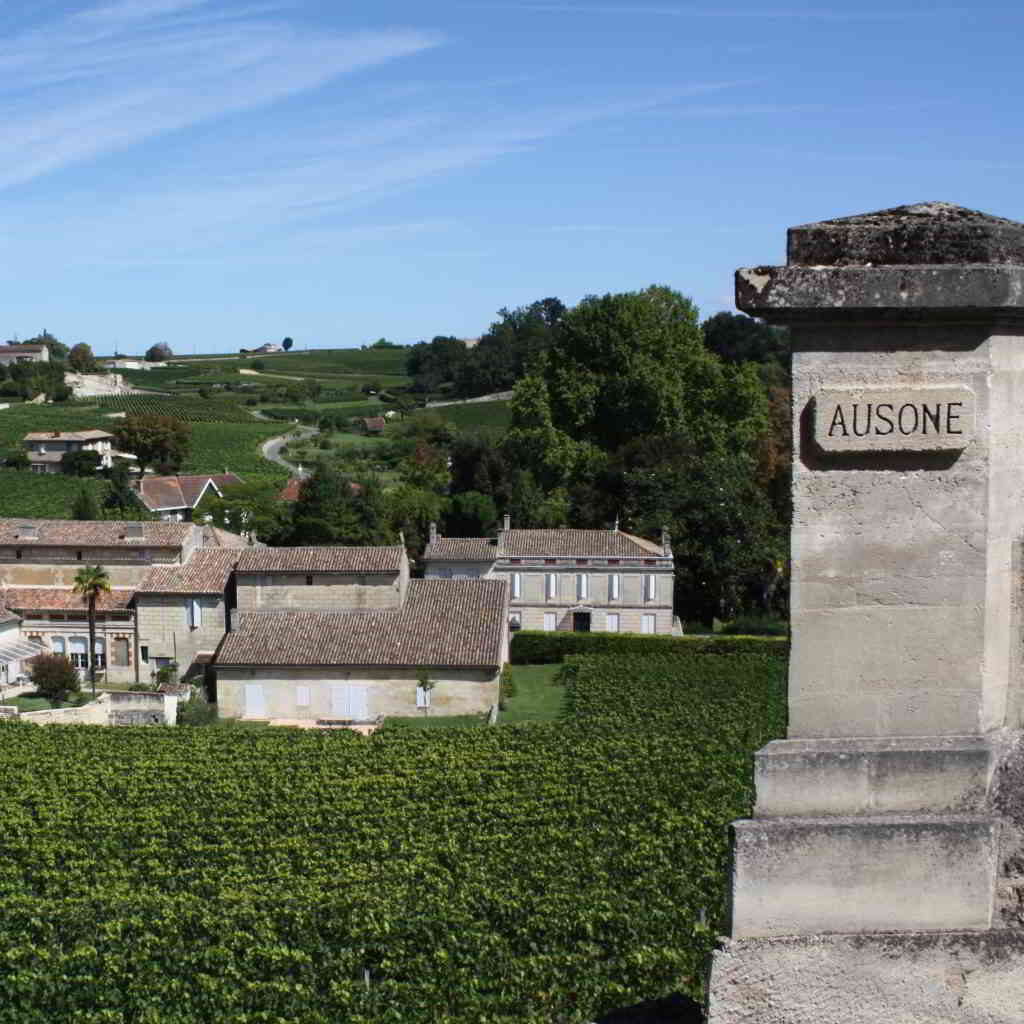
Situated on France’s northeastern border with Germany, Alsace is better-known for its quaint little villages, rustic vineyards and distinctive cuisine than for its castles. Yet there are some truly lovely chateaux in this off-the-beaten-track region that merit a visit. If you decide to spend some of your luxury getaway in Alsace, don’t hesitate to include some of these breathtaking structures on your itinerary.
Standing on a high bluff and overlooking beautiful vineyards, the Chateau Haut-Koenigsbourg was originally built during the 12th century. Restored to its former glory in 1889 and during the height of European Romanticism, the castle emblematises the medieval Alsatian style. Its impressive fortifications and turrets, elegant tapestries and medieval weaponry collection attract scores of visitors each year. It makes for an excellent stop on a wine tour in the village of Orschwiller, a prized spot on the Alsace Wine Route.
Meanwhile, Fleckenstein Castle is a dramatic ruin rather than an intact castle– but for architecture and history fans visiting Alsace, it’s a must. Situated on a rocky, high outcrop and standing at an altitude of nearly 340 metres, the ruins are fascinating to explore. A mighty fortified Chateau stood here from the 12th through the 17th centuries; it was destroyed by French troops during a large battle in 1680.
You can still see the square tower and the remnants of the castle’s rooms, which seem to meld into the rock face. Myth and magic come together at this unique site.
Other sublime and fascinating chateaux to visit in the Alsace-Lorraine region include Ortenbourg Castle, an epic fortified structured high on a hill that’s only accessible on foot. It overlooks the famed wineries of Scherwiller, so a visit to the castle in the morning, followed by an afternoon of wine-tasting, is a distinct possibility. Finally, for those interested in neoclassical architecture, the Rohan Castle may be of interest: often referred to as the “Little Versailles of Alsace”, it shares some of its 18th-century grandiosity and pomp.
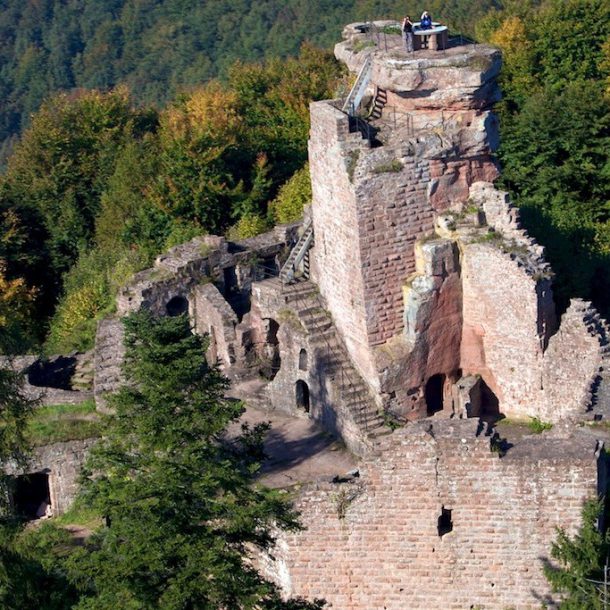
As the seat of French royal power for most of the country’s history, you’d expected Paris and its surrounding region to boast some pretty impressive chateaux. And indeed, they do– even though these tend to be less of the “fairytale” variety found in the Loire, Burgundy or Alsace. Demonstrating absolute royal and military force, these castles were above all created to inspire fear and respect. But– and this is an important point– great beauty and opulence were viewed as necessary ingredients in creating that sense of sheer power.
Starting in central Paris, the Louvre was originally not a museum, but a royal palace-chateau that snaked around the then-boundaries of Paris with enormous fortified walls. Countless French monarchs ruled from the Louvre, until Louis XIV (the “Sun King”) decided to decamp to the lavish Versailles outside the city limits. Today, visiting the foundations of the Louvre offers a fascinating understanding of how Paris has evolved over the centuries, from medieval city whose walls remained close to the Seine and the Ile de la Cité, to sprawling metropolis today.
Of course, heading outside Paris to the Chateau de Versailles, the grandeur of the French absolutist monarchy comes into startling picture. The mammoth Palace and gardens, with its opulent Hall of Mirrors, golden decor, lavish furniture, sprawling, harmonious gardens, Grand and Petit Trianon royal residences seem emblematic of Louis XIV’s powerful presence.
Lesser-Known Castles in Close Reach of Paris
Initially a hunting lodge under Louis XIII, it was expanded into a full-fledged Chateau and Palace under the Sun King, who was envious of the finance minister Fouquet’s own palace at Vaux-le-Vicomte (another lavish Chateau outside of Paris that’s worth a visit, incidentally.)
In addition to Versailles and the Vaux-le-Vicomte, the Chateau de Fontainebleau is another former hunting lodge with a lavish castle and gardens, surrounded by verdant forest with walking trails– ideal for nature lovers. Inhabited for over seven centuries by monarchs and Emperors, Fontainebleau boasts an astounding 1,500 rooms. While it’s less famous than Versailles, it has much to offer anyone with a deep interest in French and royal history, as well as architecture and landscaping.
Finally, to the direct east of Paris, the much-overlooked Chateau de Vincennes is a remarkably well-preserved fortified castle complete with a keep (donjon) and moat. Situated next to the enormous Bois de Vincennes park/woodlands, the medieval Chateau was built in the 12th century as a hunting lodge. Many kings, queens and other royal family members lived, married and died there, and the chateau was also occupied by German Nazi (SS) soldiers during World War II. French resistance fighters were executed onsite and today the Chateau holds significance as a memorial site as well as a site of formal royal power.
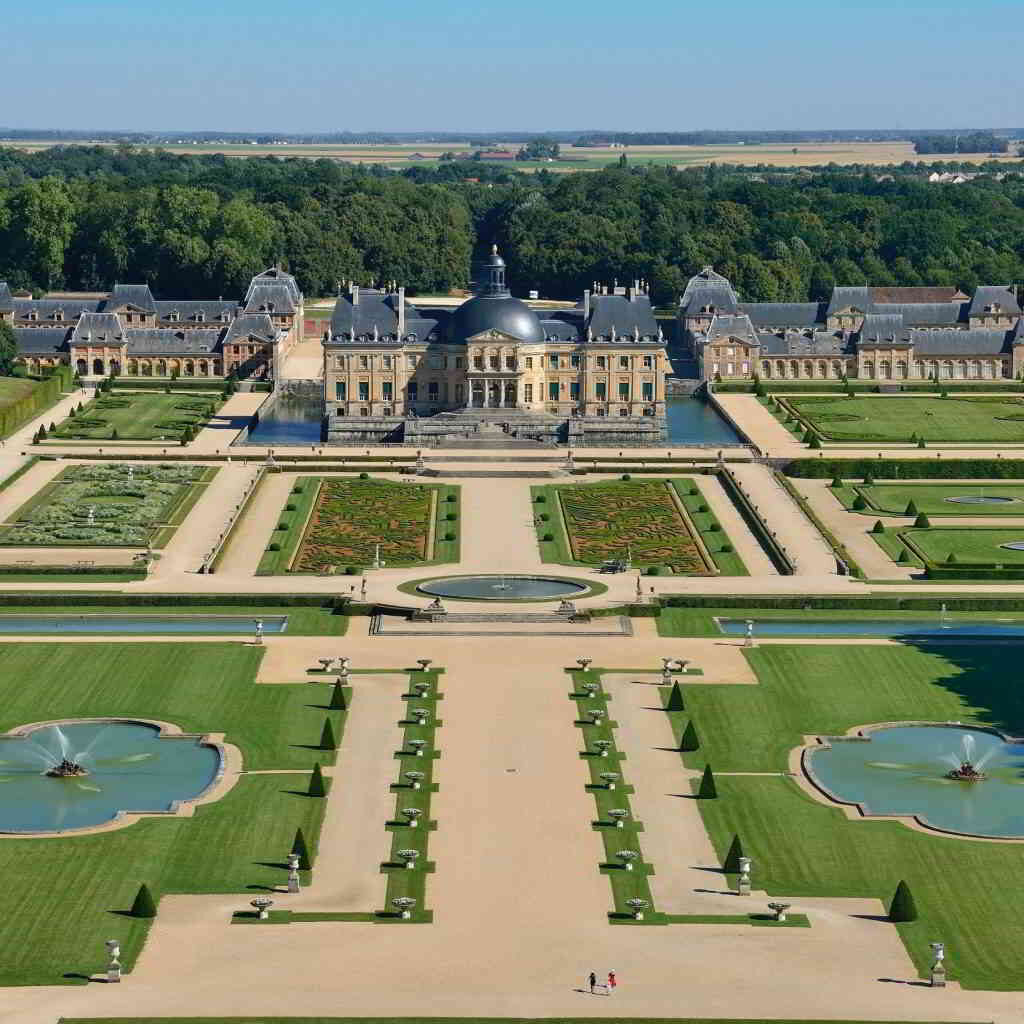
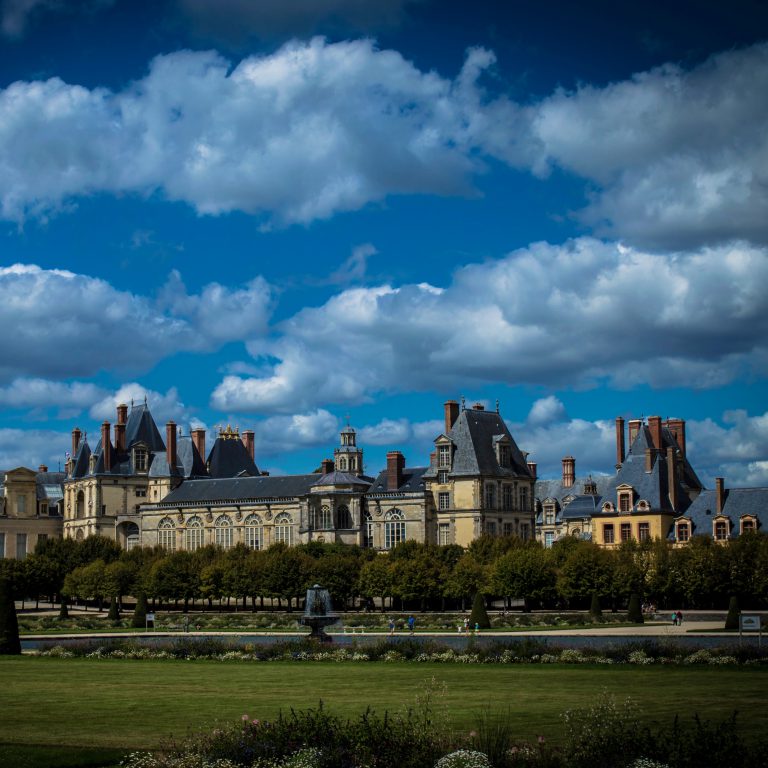
Last but certainly not least, Burgundy is home to many breathtaking castles, dating from as early as the medieval period and stretching into the Renaissance. While most people primarily associate the region with excellent wines– and for good reason– it’s also a fantastic destination for anyone interested in French history and architecture.
Medieval Burgundian Splendor
The glory of the Dukes of Burgundy, who ruled a powerful kingdom independent from France from the 9th century through part of the 11th, can still be discerned in structures such as the Chateau de la Rochepot, a distinctive neo-gothic-style castle plunged in the green hills around Rochepot. This 12th century castle shows off some of the typical Burgundian style also noticeable in the famous Hospices de Beaune, with its patterned, glazed roof tiles and dramatic turrets. Wine tastings and private events can be enjoyed at this elegant chateau– making it an ideal stop on any luxury traveler’s itinerary.
Next, the legendary Chateau du Clos de Vougeot is one of Burgundy’s most important cultural sites, after the winemaking order known The Confrérie des Chevaliers du Tastevin purchased the Château in 1945, restored it to its former glory and transformed it into the seat of the Order. Plunged in vineyards, it was originally a wine farm, constructed during the 12th century by monks from the Abbey de Citeaux. The dramatic walled castle you see today was mostly constructed during the Renaissance, but some of the buildings date to the medieval period. Inside, visitors can take in medieval presses, a vat-house, Cistercian cellars and centuries-old kitchens. It also houses an acclaimed restaurant serving typical local gastronomy.
While the Clos de Vougeot no longer produces wine, it remains a stunning site in the Burgundian countryside, and an essential stop for anyone wishing to better understand the intertwining history of religion and winemaking in the region.
Finally, this one will please the architects and fantasy lovers out there: the Chateau de Guédelon is a neo-medieval fortified castle whose construction began…in 2015! The bold experiment seeks to recreate a high-medieval castle and fortifications from models left behind by Philip II Augustus, who was notably responsible for the Palais du Louvre. While it’s still under construction as this goes to press, visiting the site to see the castle underway is an interesting prospect for some.
Jewels from the Renaissance
It’s not only the nearby Loire whose Renaissance-era castles exude a kind of storybook romance. Sprawling, beautiful sites such as the Chateau de Sully are equally mesmerising and elegant. Situated only 30 minutes from Beaune, the castle stands on the site of a former Roman fortress with eight towers; it was also later occupied by the Dukes of Burgundy. Today, an enormous moat is surrounded by four completely distinctive facades, each with sublime design details that have led it to be called the region’s finest castle.
Nestled in the Cote de Beaunes winemaking appellation, the Chateau de Sully has its own adjoining vineyards and offers onsite wine tastings in the cellars there. Onsite at the castle, private receptions and gastronomic dinners are also a possibility. This might also be an ideal venue for a luxury wedding or engagement party in France.
Meanwhile, Renaissance-era chateau-hotels and spas such as the Chateau de Courban and the Chateau de Valléry offer true luxury and relaxation, as well as centuries of history. The former has a Michelin-starred restaurant and a spa with products from Nuxe. Both are additional venues ideal for a prestigious and original wedding or anniversary party.
Did you like the content? Share it now!
Are you ready to embark on your own bespoke luxury getaway to France? Whether you’re interested in touring remarkable chateaux, tasting local wines, or renting a prestigious French castle for a private celebration, we offer nothing but the very best. Just get in touch with us to start crafting your private package or tour.
Did you like the content? Share it now!
To provide the best experiences, we use technologies like cookies to store and/or access device information. Consenting to these technologies allows us to process data such as browsing behavior or unique IDs on this site. Not consenting or withdrawing consent may negatively affect certain features and functions.
